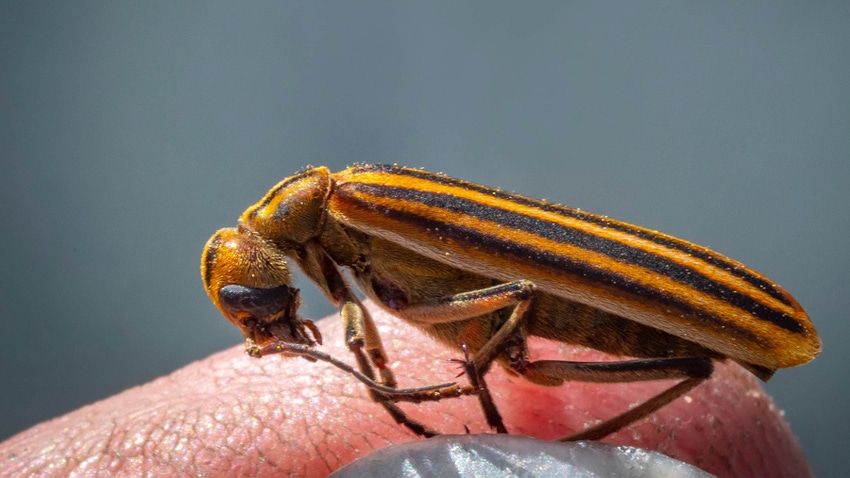
Blister beetles in alfalfa cut throughout the summer months are an ongoing concern for horse owners in the southern and eastern regions of the U.S. The consequences can be deadly if a horse eats a blister beetle, alive or dead, while munching on the hay.
Weather patterns consistently exhibiting hot, dry conditions with intermittent rainfall can increase blister beetle populations. Traditional recommendations for blister beetle management focus on hay fields and hay from potentially infested fields.
Kelly Seuhs, Oklahoma State University Extension specialist in forage entomology and alfalfa, said many of Oklahoma’s blister beetles are drawn to blooming plants, resulting in large mating swarms. Blister beetles have been spotted in barns because native species are attracted to broadleaf weeds that grow near the structures.
Identifying blister beetles and signs of toxicity
Blister beetles can range in size from three-quarters of an inch to 1 1/4 inches in length with narrow bodies and antennae that are one-third the length of their entire bodies. Four species common in Oklahoma are margined, black, ashgray and striped.
“The one we really need to worry about is the striped blister beetle,” Seuhs said. “They have the highest concentration of cantharidin, which is a blistering agent produced by the beetle as a defense mechanism.”
The blistering agent is toxic, and if a horse consumes blister beetles in high enough quantities, it may exhibit the following symptoms:
Sores or blisters on the tongue and in the mouth
Colic
Straining
Increased temperature
Depression
Increased heart and respiratory rates
Dehydration
Sweating
Diarrhea
Bloody feces
Frequent urination
Seuhs said ruminant livestock, such as cattle and goats, can also be affected by blister beetles but generally not as severely as horses.
Signs of blister beetle toxicity typically occur within 3-12 hours after ingestion. It can be difficult to determine if horses have consumed blister beetles because horses could exhibit common symptoms of colic. A low fever, refusing feed, or acting depressed or lethargic are also possible signs a horse has ingested blister beetles.
Kris Hiney, OSU Extension’s equine specialist, said irritation of a horse’s mouth and mucous membranes may cause the animal to appear they are playing in or dunking their head in water. They may also display signs of straining and the need to urinate.
The cantharidin in beetles affects key electrolytes, which dysregulate breathing and elevate heart rate. The conditions can be fatal, and a veterinarian should be contacted immediately if blister beetle poisoning is suspected. The sooner a horse is treated, the greater the chance of survival.
Preventing blister beetles
Scouting alfalfa along field borders for beetles before the hay is baled can save a horse’s life. Seuhs said the insects are notorious for swarming and are known to congregate. They’re most active in the summer, and when a swarm is present, the ground will appear to move.
Hay most often becomes contaminated with blister beetles when they are crushed in alfalfa from the swather. Beetles are killed by the crimper rollers and become trapped in the hay. The remains of blister beetles may be concentrated in a small portion of the hay from a field. Beetles are also trapped and killed when forage is driven on before the beetles have had time to escape.
If left alone, most blister beetles leave alfalfa shortly after cutting. Harvesting the hay without using crimpers and avoiding wheel traffic on freshly cut alfalfa are two of the best ways to avoid problems.
The OSU Extension fact sheet on blister beetle activity advises alfalfa producers to take the following measures to avoid blister beetles in hay:
Maintain weed control within and outside the field.
Spray entire fields with a short residual insecticide just before harvesting. Spray the fence rows and field borders as well; or
Inspect fields shortly before cutting and spray only the infested areas if any are found.
Harvest alfalfa before it blooms, if possible.
Seuhs said treating fields for grasshoppers as early as possible in the spring can help reduce beetle numbers. Blister beetles feed on grasshopper eggs laid in the cracks and crevices of the ground as a nutrient source for the winter. The size of a grasshopper population can be a sign of next season’s blister beetle infestation.
While there is no way to eliminate the possibility of blister beetles in alfalfa completely, the best management approach is to take precautions to reduce the likelihood of their presence.
The OSU Extension fact sheet on blister beetles also provides tips to horse owners on how to purchase alfalfa safe for horses. Recommendations include:
Know the alfalfa supplier.
Ask producers what precautions were taken to avoid blister beetles in forage.
Inspect hay before feeding if blister beetles are suspected.
If feeding small amounts of alfalfa, examine each flake for concentrations of dead blister beetles.
Purchase hay harvested before May or after September. This will not guarantee hay free of blister beetles but will significantly reduce the risk.
OSU Extension Fact Sheet Resources
Blister Beetles and Alfalfa
Be Aware of Blister Beetle Activity
Read more about:
HorsesAbout the Author(s)
You May Also Like




